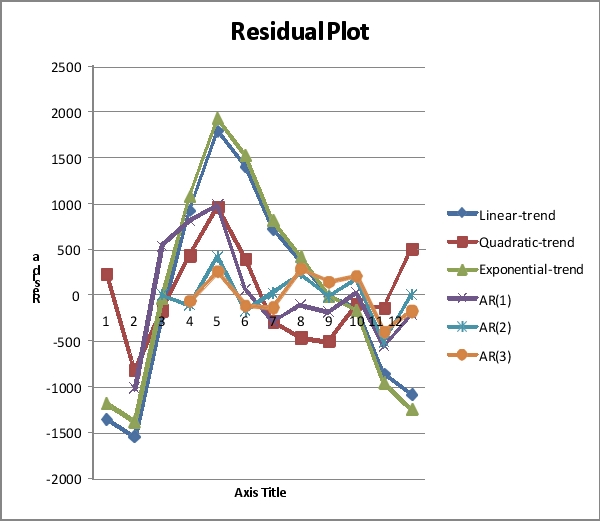SCENARIO 16-13
Given below is the monthly time series data for U.S.retail sales of building materials over a specific year.
 The results of the linear trend,quadratic trend,exponential trend,first-order autoregressive,second-order autoregressive and third-order autoregressive model are presented below in which the coded month for the 1st month is 0:
The results of the linear trend,quadratic trend,exponential trend,first-order autoregressive,second-order autoregressive and third-order autoregressive model are presented below in which the coded month for the 1st month is 0:
Linear trend model:

Quadratic trend model:


 Third-order autoregressive::
Third-order autoregressive::

Below is the residual plot of the various models:

-Referring to Scenario 16-13,what is the p-value for the t test statistic for testing the significance of the quadratic term in the quadratic-trend model?
Definitions:
Sunk Cost
Costs that have already been incurred and cannot be recovered, which should not influence future business decisions.
Period Cost
Expenses that are not directly tied to the production process and are charged to the period in which they are incurred.
Future Decisions
Decisions that will be made in the future, often based on forecasts or projections.
Variable Cost Method
A pricing strategy that only accounts for direct materials, direct labor, and variable manufacturing overhead costs, excluding any fixed costs from its calculations.
Q17: Referring to Scenario 15-7-B, you should not
Q24: Referring to Scenario 14-5, what fraction of
Q103: Referring to Scenario 14-5, one company in
Q122: A multiple regression is called "multiple" because
Q135: Referring to Scenario 14-9, the value
Q139: Referring to Scenario 14-17, which of the
Q196: Referring to Scenario 17-10 Model 1, what
Q198: Referring to Scenario 16-15-B, you can conclude
Q203: Four surgical procedures currently are used
Q229: Referring to Scenario 17-13, the sparklines enable